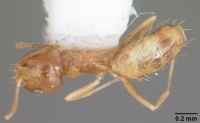Brachymyrmex minutus
| Brachymyrmex minutus | |
|---|---|
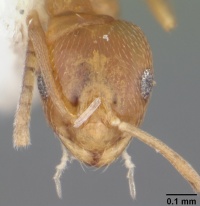
| |
| Scientific classification | |
| Kingdom: | Animalia |
| Phylum: | Arthropoda |
| Class: | Insecta |
| Order: | Hymenoptera |
| Family: | Formicidae |
| Subfamily: | Formicinae |
| Tribe: | Myrmelachistini |
| Genus: | Brachymyrmex |
| Species: | B. minutus |
| Binomial name | |
| Brachymyrmex minutus Forel, 1893 | |
Forel (1893) found several colonies subterraneous at the roots of sod, usually where it overgrows rocks, typically within the forest and/or nearby streams. The nest of B. minutus consists of large tunnels with small chambers at intervals. Colonies contain ~ 50 to 100 individuals, with a single queen.
| At a Glance | • Limited invasive |
Identification
Ortiz-Sepulveda et al. (2019) - Brachymyrmex minutus morphologically resembles Brachymyrmex australis, Brachymyrmex aphidicola, and Brachymyrmex termitophilus, because all these species have eyes located on the cephalic midline, a mesonotum that does not bulge dorsally above the pronotum in lateral view, and yellowish body color. Brachymyrmex minutus differs from the three other species, or any other Brachymyrmex species for that matter, by having a very inconspicuous mesometanotal suture, giving the impression that the mesonotum and metanotum are fused. Additionally, B. minutus differs from B. termitophilus by having scattered pubescence on the gaster, from B. aphidicola by the presence of only two erect hairs on the pronotum and from B. australis by having scapes that surpass the posterior margin of the head by a length that is smaller than the maximal diameter of the eye.
Keys including this Species
Distribution
In Florida this is an uncommon species that is thought to be a human introduction from the West Indies. It is known from tropical hammocks in Dade and Monroe counties. Nests are in leaf litter. The identity of this species and virtually all other Brachymyrmex is problematical. Pest status: none. First published Florida record: Ferster and Prusak 1994; earlier specimens: 1984. (Deyrup, Davis & Cover, 2000.)
Latitudinal Distribution Pattern
Latitudinal Range: 23.133° to -24.1°.
| North Temperate |
North Subtropical |
Tropical | South Subtropical |
South Temperate |
- Source: AntMaps
Distribution based on Regional Taxon Lists
Neotropical Region: Bolivia, Brazil, Colombia, Costa Rica, Cuba, Dominican Republic, Ecuador, French Guiana, Greater Antilles, Guatemala, Lesser Antilles, Martinique, Mexico, Netherlands Antilles, Panama, Paraguay, Peru, Suriname, Venezuela.
Distribution based on AntMaps
Distribution based on AntWeb specimens
Check data from AntWeb
Countries Occupied
| Number of countries occupied by this species based on AntWiki Regional Taxon Lists. In general, fewer countries occupied indicates a narrower range, while more countries indicates a more widespread species. |

|
Estimated Abundance
| Relative abundance based on number of AntMaps records per species (this species within the purple bar). Fewer records (to the left) indicates a less abundant/encountered species while more records (to the right) indicates more abundant/encountered species. |

|
Biology
Castes
Queen
Images from AntWeb
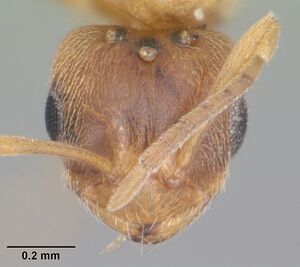 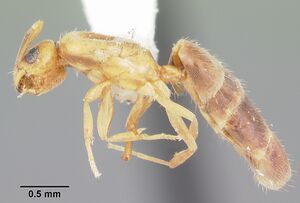 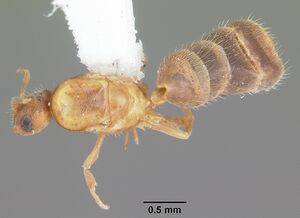 
| |
| Queen (alate/dealate). Specimen code casent0103626. Photographer April Nobile, uploaded by California Academy of Sciences. | Owned by ABS, Lake Placid, FL, USA. |
Nomenclature
The following information is derived from Barry Bolton's Online Catalogue of the Ants of the World.
- minutus. Brachymyrmex minutus Forel, 1893g: 346 (w.q.) ST VINCENT & THE GRENADINES (St Vincent), VIRGIN IS (St Thomas).
- Type-material: lectotype worker (by designation of Ortiz-Sepúlveda, et al. 2019: 509), 14 paralectotype workers, 1 paralectotype queen.
- Type-locality: lectotype St Vincent & the Grenadines: St Vincent I. (H.H. Smith); paralectotypes with same data.
- [Notes (i): Ortiz-Sepúlveda, et al. 2019: 509, give no type-locality details; (ii) the original description cites the following localities for minutus on St Vincent I.: Petit Bordelle Valley, 1200 ft, 12.xi., nos 47a, 47b, 47c (H.H. Smith), Morne à Garou, 2000 ft, 1.xi., no. 47d (H.H. Smith), Upper Richmond Valley, 1500 ft, 27.xi., nos 47e, 47f (H.H. Smith), Soufrière Volcano, 2500 ft, ix., no. 57e (H.H. Smith), Wallilobo Valley, 500 ft, 8.xi., no. 57f (H.H. Smith).]
- Type-depository: MHNG.
- Status as species: Wheeler, W.M. 1905b: 111, 132; Forel, 1912i: 62; Wheeler, W.M. 1922c: 15; Santschi, 1923b: 667; Emery, 1925b: 43; Stärcke, 1926: 118 (in key); Aguayo, 1932: 224; Smith, M.R. 1954c: 11; Kempf, 1972a: 40; Alayo, 1974: 26 (in key); Bolton, 1995b: 82; Deyrup, et al. 2000: 301; Deyrup, 2003: 44; Deyrup, 2017: 181; Fernández & Ortiz-Sepúlveda, 2019: 728; Ortiz-Sepúlveda, et al. 2019: 509 (redescription).
- Distribution: Bolivia, Brazil, Colombia, Costa Rica, Cuba, Dominican Republic, Ecuador, French Guiana, Guatemala, Mexico, Panama, Paraguay, Peru, Suriname, St Vincent & the Grenadines, Venezuela, Virgin Is.
Unless otherwise noted the text for the remainder of this section is reported from the publication that includes the original description.
Description
Worker
Ortiz-Sepulveda et al. (2019) - Lectotype and paralectotypes (n = 4). HL1 0.37–0.40; HL2 0.25–0.31; HL30.07–0.10; HW 0.32–0.36; SL 0.32–0.36; EL 0.08–0.11; WL n.a.; PnL n.a.; PnW 0.20–0.24; ML 0.06–0.07; MW 0.14–0.15; Indices CI 85.88–89.29; SI1 92.59–108.00; SI2 107.14–126.67; OI1 26.03–29.63; OI2 20.00–25.27.
Head. Slightly longer than wide in full face view; posterior cephalic margin weakly convex. Dorsum of the head with sparse hairs. Clypeus with a rounded anterior margin and five long, erect hairs of which a single, usually conspicuous hair is near the anterior margin, two hairs are in mediolateral position, and two more near the toruli; other hairs on the clypeus are markedly shorter and appressed or decumbent. Toruli surpassing the posterior clypeal margin in oblique anterodorsal oblique view. The scapes surpass the posterior margin of the head by a length that is smaller than the maximal diameter of the eye; they have appresed pubescence. Ocelli absent. Eyes are positioned on the cephalic midline and have 8–9 ommatidia along their maximal diameter.
Mesosoma. Typically with two erect hairs on the pronotum and without erect hairs on the mesonotum. The mesonotum is not inflated and does not bulge dorsally above the pronotum in lateral view. Mesometanotal suture inconspicuous, giving the impression that the mesonotum and metanotum are fused. Metanotal groove absent or narrower than the diameter of the metathoracic spiracles. Metathoracic spiracles in dorsolateral position, not protruding, and touching the propodeal suture. Dorsum of the propodeum slightly convex and shorter than the propodeal slope. Propodeal spiracles circular, positioned on the posterior propodeal margin, just dorsally at the middle of the propodeal slope. Legs with appressed and scattered hairs. Petiole short and inclined forward.
Gaster. With scarce pubescence and several scattered long suberect hairs.
Color and sculpture. Body smooth, or finely granulated and shiny, sometimes with some imbricate sculpture on the dorsum of the mesosoma. Body usually yellowish, but sometimes reddish.
Type Material
Ortiz-Sepulveda et al. (2019) - Brachymyrmex minutus Forel, 1893: 346 (w.q.). Lectotype worker (Musee d'Histoire Naturelle Genève: USNMENT00757150) and paralectotype workers, queen (MHNG: USNMENT00757149–00757151; USNMENT00758110–00758112; here designated): 15 workers, one queen [examined]. ANTILLES: Saint Vincent. See also: Santschi (1923a: 667).
The lectotype is designated here as the second ant counting from the top of pin MHNG: USNMENT00757150, whereas the other specimens on that pin are paralectotypes.
References
- Albuquerque, E., Prado, L., Andrade-Silva, J., Siqueira, E., Sampaio, K., Alves, D., Brandão, C., Andrade, P., Feitosa, R., Koch, E., Delabie, J., Fernandes, I., Baccaro, F., Souza, J., Almeida, R., Silva, R. 2021. Ants of the State of Pará, Brazil: a historical and comprehensive dataset of a key biodiversity hotspot in the Amazon Basin. Zootaxa 5001, 1–83 (doi:10.11646/zootaxa.5001.1.1).
- Cantone S. 2018. Winged Ants, The queen. Dichotomous key to genera of winged female ants in the World. The Wings of Ants: morphological and systematic relationships (self-published).
- Deyrup, M., Davis, L. & Cover, S. 2000. Exotic ants in Florida. Transactions of the American Entomological Society 126, 293-325.
- Forel, A. 1893j. Formicides de l'Antille St. Vincent, récoltées par Mons. H. H. Smith. Trans. Entomol. Soc. Lond. 1893: 333-418 (page 346, worker, queen described)
- Lubertazzi, D. 2019. The ants of Hispaniola. Bulletin of the Museum of Comparative Zoology, 162(2), 59-210 (doi:10.3099/mcz-43.1).
- Ortiz-Sepulveda, C.M., Van Bocxlaer, B., Meneses, A.D., Fernández, F. 2019. Molecular and morphological recognition of species boundaries in the neglected ant genus Brachymyrmex (Hymenoptera: Formicidae): toward a taxonomic revision. Organisms Diversity & Evolution (DOI 10.1007/s13127-019-00406-2).
- Varela-Hernández, F., Medel-Zosayas, B., Martínez-Luque, E.O., Jones, R.W., De la Mora, A. 2020. Biodiversity in central Mexico: Assessment of ants in a convergent region. Southwestern Entomologist 454: 673-686.
- Vidal-Cordero, J.M. 2022. Brachymyrmex patagonicus Mayr, 1868 (Hymenoptera, Formicidae). Primera cita para la Provincia de Murcia (España). Iberomyrmex (Diciembre 2022).
- Wetterer, J.K. 2021. Ants (Hymenoptera, Formicidae) of St. Vincent, West Indies. Sociobiology 68, e6725 (doi:10.13102/sociobiology.v68i2.6725).
References based on Global Ant Biodiversity Informatics
- Aguayo C. G. 1932. Notes on West Indian ants. Bulletin of the Brooklyn Entomological Society 27: 215-227.
- Alayo D. P. 1974. Introduccion al estudio de los Himenopteros de Cuba. Superfamilia Formicoidea. Academia de Ciencias de Cuba. Instituto de Zoologia. Serie Biologica no.53: 58 pp. La Habana.
- Boer P. 2019. Ants of Curacao, species list. Accessed on January 22 2019 at http://www.nlmieren.nl/websitepages/SPECIES%20LIST%20CURACAO.html
- Boer P. 2019. Ants of Saba, species list. Accessed on January 22 2019 at http://www.nlmieren.nl/websitepages/SPECIES%20LIST%20SABA.html
- Culver D. C. 1974. Species packing in Caribbean and North Temperate ant communities. Ecology 55(5): 974-988.
- Dattilo W. et al. 2019. MEXICO ANTS: incidence and abundance along the Nearctic-Neotropical interface. Ecology https://doi.org/10.1002/ecy.2944
- Deyrup M., L. Davis, and S. Buckner. 1998. Composition of the ant fauna of three Bahamian islands. Proceedings of the seventh symposium on the natural history of the Bahamas. 23-32. Bahamian Field Station, San Salvador, Bahamas
- Fernandes, P.R. XXXX. Los hormigas del suelo en Mexico: Diversidad, distribucion e importancia (Hymenoptera: Formicidae).
- Fernandez Triana J. L., H. Sariol, M. A. Vega Castillo, S. Ricardo, M. Gonzalez, and E. P. Ferrer. 2002. Datos preliminares dobre la biodiversidad del orden Hymenoptera en la provincia Granma, Cuba. Bol. S.E.A. 31: 43-48.
- Fernández, F. and S. Sendoya. 2004. Lista de las hormigas neotropicales. Biota Colombiana Volume 5, Number 1.
- Fontanla Rizo J.L. 1997. Lista preliminar de las hormigas de Cuba. Cocuyo 6: 18-21.
- Fontenla J. L., and J. Alfonso-Simonetti. 2018. Classification of Cuban ants (Hymenoptera: Formicidae) into functional groups. Poeyana Revista Cubana de Zoologia 506: 21-30.
- Fontenla Rizo J. L. 1993. Composición y estructura de comunidades de hormigas en un sistema de formaciones vegetales costeras. Poeyana. Instituto de Ecología y Sistemática, Academia de Ciencias de Cuba 441: 1-19.
- Fontenla Rizo J. L. 1993. Mirmecofauna de Isla de la Juventud y de algunos cayos del archipielago cubano. Poeyana. Instituto de Ecologia y Sistematica, Academia de Ciencias de Cuba 444:1-7.
- Fontenla Rizo J. L. 1997. Lista preliminar de las hormigas de Cuba (Hymenoptera: Formicidae). Cocuyo 6: 18-21.
- Forel A. 1912. Formicides néotropiques. Part VI. 5me sous-famille Camponotinae Forel. Mémoires de la Société Entomologique de Belgique. 20: 59-92.
- Kempf, W.W. 1972. Catalago abreviado das formigas da regiao Neotropical (Hym. Formicidae) Studia Entomologica 15(1-4).
- Koptur, S., M. Palacios-Rios, C. Diaz-Castelazo, W. P. Mackay, and V. Rico-Gray. 2013. Nectar secretion on fern fronds associated with lower levels of herbivore damage: field experiments with a widespread epiphyte of Mexican cloud forest remnants. Annals of Botany 111: 1277-1283.
- Llyod, Morrison W. 2002. Island bigeography and metapopulation dynamics of Bahamianan ants. Journal of Biogeography. 29:387-394.
- Longino, J.T. 2010. Personal Communication. Longino Collection Database
- Morrison L. W. 1998. A review of Bahamian ant (Hymenoptera: Formicidae) biogeography. Journal of Biogeography 25: 561-571.
- Morrison, Lloyd W. 1998. The Spatiotemporal Dynamics of Insular Ant Metapopulations. Ecology. 79(4):1135-1146.
- Morrison, Lloyd. 2006. The Ants of Small Bahamian Cays. Bahamas Naturalist & Journal of Science. 1(2):27-32.
- Ortiz-Sepuvelda C. M., B. Van Bocxlaer, A. D. Meneses, and F. Fernandez. 2019. Molecular and morphological recognition of species boundaries in the neglected ant genus Brachymyrmex (Hymenoptera: Formicidae): toward a taxonomic revision. Organisms Diversity & Evolution https://doi.org/10.1007/s13127-019-00406-2
- Portuondo E. F., and J. L. Reyes. 2002. Mirmecofauna de los macizos montañosos de Sierra Maestra y Nipe-Sagua-Baracoa. Cocuyo 12: 10-13
- Portuondo E. F., and J. L. Reyes. 2006. Species of Hymenoptera recorded in the Reserva Ecológica Pico Mogote, Santiago de Cuba Province, 20-25 September 2002. In: Maceira F., D., A. Fong G., y/and W. S. Alverson, eds. 2006. Cuba: Pico Mogote. Rapid Biological Inventories Report 09. The Field Museum, Chicago.
- Portuondo Ferrer E., and J. L. Fernández Triana. 2005. Species of hymenopterans (bees, wasps, and ants) recorded in Alejandro de Humboldt National Park, from literature records, revision of the collection at BIOECO, and collections before and during the rapid inventory, 12-22 February 2004. In Fong G., A., D. Maceira F., W. S. Alverson, y/and T. Wachter, eds. 2005. Cuba: Parque Nacional Alejandro de Humboldt. Rapid Biological Inventories Report 14. The Field Museum, Chicago.
- Portuondo Ferrer, E. and J. Fernandez Triana. Biodiversidad del orden Hymenoptera en Los Macizos Montanosos de Cuba Oriental. Boletin S.E.A. 35:121-136.
- Reyes, J. L. "Inventario de la colección de hormigas (Hymenoptera: Formicidae) del Centro Oriental de Ecosistemas y Biodiversidad, Santiago de Cuba, Cuba." Boletín de la Sociedad Aragonesa 36 (2005): 279-283.
- Santschi F. 1923. Revue des fourmis du genre Brachymyrmex Mayr. Anales del Museo Nacional de Historia Natural de Buenos Aires 31: 650-678.
- Smith, Marion R. 1954. American Museum Novitates. Ants of the Bimini Island Group, Bahamas, British West Indies (Hymenoptera, Formicidae). 1671:1-16
- Smith, Marion R. 1954. Ants of the Bimini Island Group, Bahamas, British West Indies. American Museum of Natural History. 1671. 1-16.
- Torres J.A. 1984. Niches and Coexistence of Ant Communities in Puerto Rico: Repeated Patterns. Biotropica 16(4): 284-295.
- Vásquez-Bolaños M. 2011. Lista de especies de hormigas (Hymenoptera: Formicidae) para México. Dugesiana 18: 95-133
- Wheeler W. M. 1905. The ants of the Bahamas, with a list of the known West Indian species. Bulletin of the American Museum of Natural History 21: 79-135.
- Wheeler W. M. 1908. The ants of Jamaica. Bulletin of the American Museum of Natural History 24: 159-163.
- Wheeler W. M. 1922. The ants of Trinidad. American Museum Novitates 45: 1-16.

